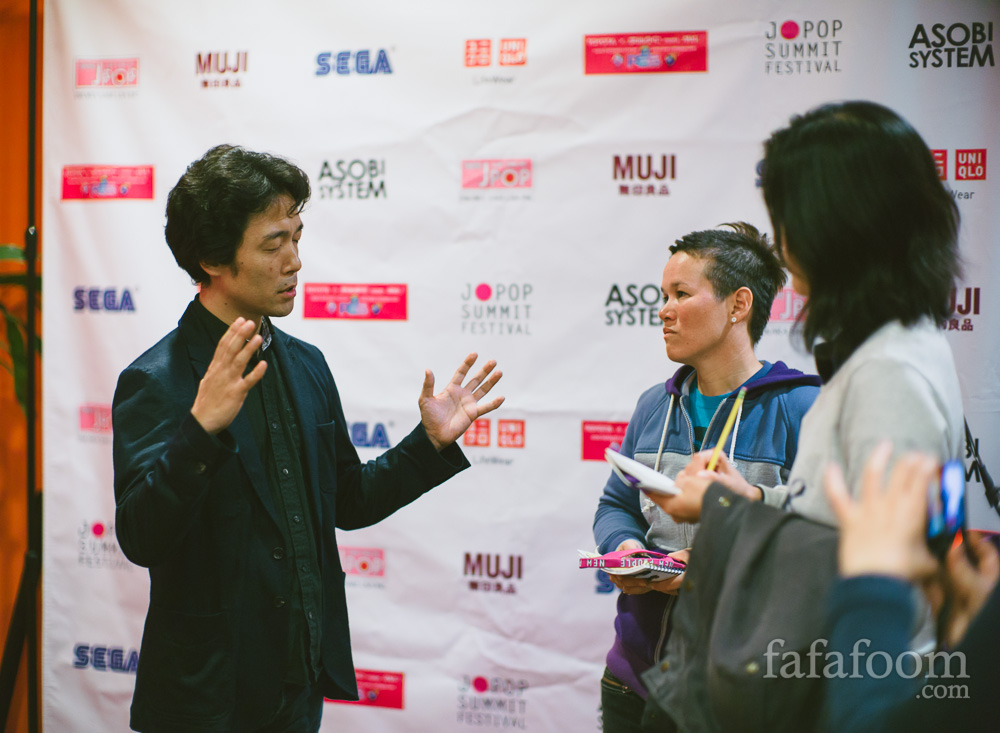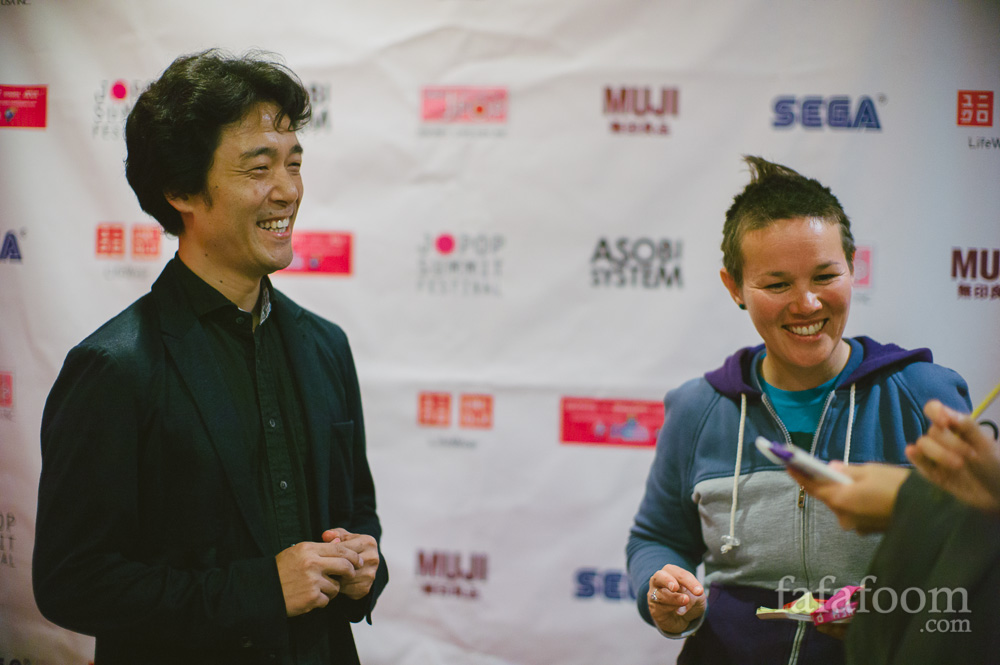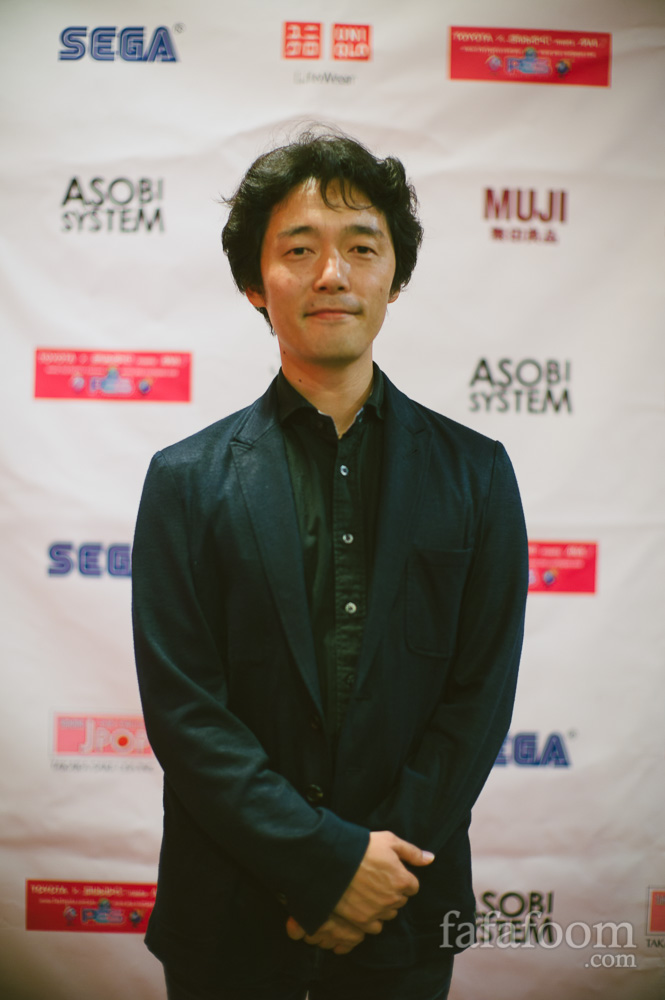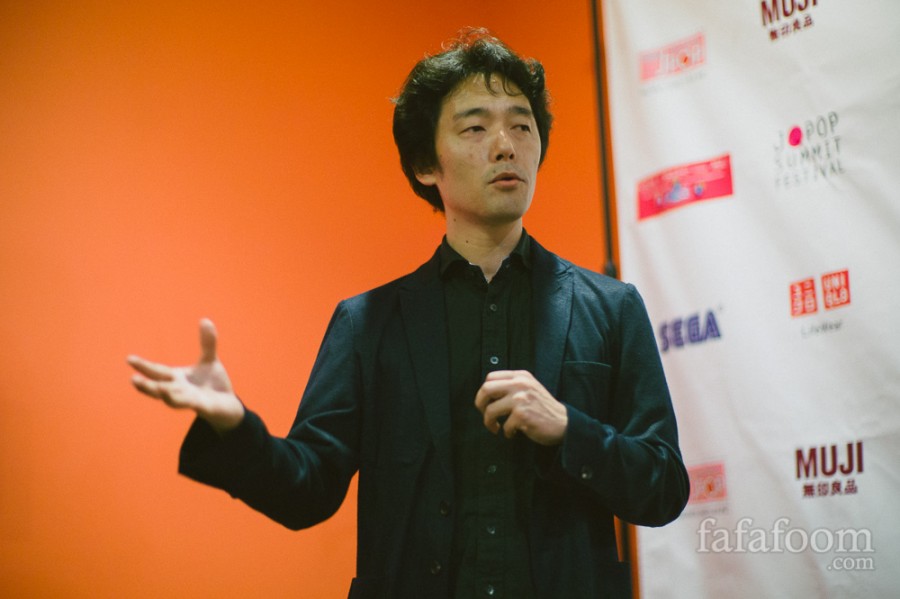We just finished watching the Library Wars (Toshokan Sensou) anime series yesterday. It was fast paced and cute, but we agree that the live action movie Library Wars directed by Shinsuke Sato is so much superior. On August 2, we went to a special Library Wars screening at NEW PEOPLE as part of the San Francisco Japan Film Festival, for which Director Shinsuke Sato himself was present for Q&A after the movie ended.
No spoilers ahead; we both love the movie even though we haven’t read the novel by Hiro Arikawa. I love the movie for its smooth story flow, multi-faceted story-telling (action, comedy, drama), and the great build-up and ending. The movie really showcased Shinsuke Sato’s success as the director. Chris also commented that Library Wars reminds him of the anime series Patlabor (he’s a big fan). The female lead was a strong woman who’s realistically portrayed, the male lead was calm, broody, yet dependable and strong. The story focused on the officers and their lives, not the war itself. (It’s perhaps worth noting that Chris is very rarely impressed with movies in general.) We’re impressed with the quality of the movie and definitely recommend you to watch it!
The discussion that followed after Library Wars movie screening was arguably just as interesting. The crowd that attended the screening was a good mix of Japanese anime/movie lovers and general movie lovers, therefore creating a great dynamic range of questions and remarks. (Mika Anami was Shinsuke Sato’s English translator. She’s awesome, by the way.) Will there be a sequel? Is there a censorship issue in Japan? Read further if you’re curious.
Right of the bat, someone asked what Director Sato thinks about Fahrenheit 451. He acknowledged that Fahrenheit 451 is definitely the origin of this type of movies with topics of censorship and book-burning, a disorder within a system of control. However, while Fahrenheit 451 tends to go to the dark, moodier feel, Library Wars is focusing on the lighter side of the story-telling.
 Library Wars fans know that the popular Hiro Arikawa novel has spawn manga adaptation (that is still ongoing), anime series, OVA, and anime movie, all done before this Library Wars live-action film (first released on April 27, 2013). One person asked how much of influence the previous Library Wars iterations had on this project, as well as if there was any specific challenges in making the movie.
Library Wars fans know that the popular Hiro Arikawa novel has spawn manga adaptation (that is still ongoing), anime series, OVA, and anime movie, all done before this Library Wars live-action film (first released on April 27, 2013). One person asked how much of influence the previous Library Wars iterations had on this project, as well as if there was any specific challenges in making the movie.
In response, Sato-san said that he tried to develop his own version of Library Wars and not being too influenced with how others have done. As per challenges, he said that making a movie (as opposed to making an anime series) was very different. Anime series present one half-hour episode per week for 12 weeks (this is specific to Library Wars anime series). The story-telling is much longer. On the other hand, a movie is much more condensed in time (138 minutes) – the movie covered “only” until the 4th episode of the anime series. Library Wars story has many characters, so it’s important that the characters don’t get lost in the movie. Moreover, he incorporated elements that work well in film, such as the change of mood from light-hearted to serious, the build-up leading to the ultimate Odawara battle scene, as well as the instance when the male lead Atsushi Dojo (played by Junichi Okada) loses his gun and uses martial arts to fight the enemy.
On the movie, the Library Defense Force (LDF) is a self-defense combat force; they will always let the opposition shoot first so that they can fire back (self-defense combat rule). An audience member asked whether it is a reflection of how Japan act and behave. Sato-san answered that LDF uses controlled battle time, as well as self-defense combat style that is not aimed to kill the enemy but instead scare and hold the opposition at bay. Indeed that is very Japanese, a very lawful environment. Moreover, it is kind of ironic and an interesting parallel to Japan’s unified military forces, Japan Self-Defense Force (JSDF).
The idea of “library protection force” is a hard concept. That being said, the JSDF was really supportive in this project, because Library Wars is about protection of freedom. The movie features lots of JSDF locations as well as their equipment and machinery (but NOT the weapons or battle scenes).
 Someone else asked whether there is any issue of censorship in Japan. He said there’s more review given to content targetted to youth, especially the violent, sexual content. However, there’s always the “grey zone” that creates uncertainty. The Japan’s anime industry, which is very strong and influential, unfortunately tip-toes around this “grey zone” issue. Sato-san expressed that it is a big problem, but he did not elaborate further.
Someone else asked whether there is any issue of censorship in Japan. He said there’s more review given to content targetted to youth, especially the violent, sexual content. However, there’s always the “grey zone” that creates uncertainty. The Japan’s anime industry, which is very strong and influential, unfortunately tip-toes around this “grey zone” issue. Sato-san expressed that it is a big problem, but he did not elaborate further.
He did say that there is more control of verbal terms in Japan. For example, tokoya means barber in English. It has been accepted as a common word to use, but now it’s considered derogatory in media. The use of words are more controlled, it’s almost like “eliminating” language bit by bit. With the Library Wars movie, Sato-san wants to express how this kind of change is slowly creeping up in media.
Is there any policy change(s) expected from this Library Wars movie? Sato-san affirmed that entertainment value is the goal of the movie, first and foremost. It is not to make a huge impact or create a social theme. This (the movie) is putting it (the topic of censorship) out there.
The US is undoubtedly very familiar with the censorship issue that’s really such a hot topic nowadays. Someone asked, “How about a US version of the movie?” to a series of approving noises and enthusiastic nods from several audience members. Sato-san said that it will be interesting to see. Japan is such a small country, therefore expressing two controversial sides is hard. But in the US, expressing the opposing two sides can make it like the civil war era. It’s perhaps “easier” to do (than in Japan), but it’s definitely still going to be controversial and interesting to see.
 Another asked, “Since Library Wars manga is still ongoing, is there an interest to do a sequel (to this movie)?”
Another asked, “Since Library Wars manga is still ongoing, is there an interest to do a sequel (to this movie)?”
Sato-san smiled and he said that when he was starting the project, the focus was to do a “not unrealistic” approach to a fiction. However, after the movie was wrapped, there’s indeed a demand to make a sequel and he does want to create another one. (The audience cheered after knowing his answer :)
By this time, we’re all out of the NEW PEOPLE Cinema and continued our Q&A with Shinsuke Sato at the hallway in front of the cinema (we’re not ready to let him go yet!). Then, a Japanese woman shared a remark to Sato-san. She observed that the reaction to Library Wars screening is very different between US and Japan. The US audience chuckled, laughed, and clapped during the movie, while Japanese audience is more focused on the sentimental parts of the story.
Sato-san and other Japanese audience members nodded in agreement. (I also observed that Japanese audience is content with giving remarks / comments, whereas US audience asks more questions.) Sato-san added that the movie is considered very un-Japanese. While making the movie, he doesn’t want the audience to feel like “going home after seeing a war movie”. There was a debate if it’s OK to see so many guns / battle scenes. That’s why the movie has a soft beginning that builds up to more hard, out-of-control kind of situation. Even Nana Eikura, the actress lead for Iku Kasahara, did not see the last battle scenes; she was surprised when saw the movie!
Shortly before Mika Anami shut the Q&A session for good (it’s been delightfully extended for quite a long time), I managed to ask two more questions. First, I asked about his own favorite work so far. He said he loved his independent film projects he had done in the past as a student and it’s difficult to pick a favorite. However, Library Wars is the movie in which he can show both battle scenes and daily life hand-in-hand, therefore making the project his favorite so far.
The last question was far-fetched, however I asked him anyway: does he have any plan to increase his exposure in the US market? Sato-san, ever humbled, said that the movie industry landscape between Japan and the US is vastly different – the budget, language…a totally different market. However, if he wants to, perhaps he will go to the independent route.
I would definitely see another Shinsuke Sato-directed movie, doesn’t matter if they’re independent movies or not. He’s very good in what he’s doing and appears to be a very calm and humble person, an inspiration. I’ll definitely in the lookout for his next project!
Thank you for reading, until next time,
Musank

